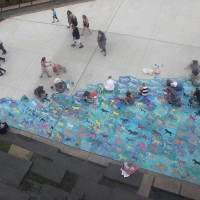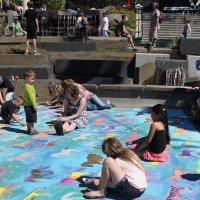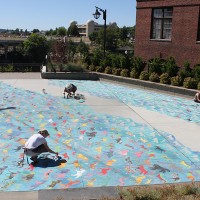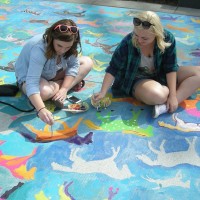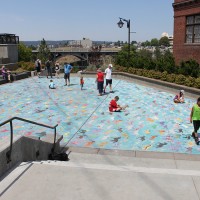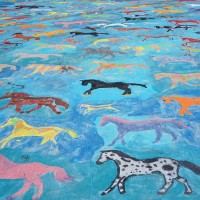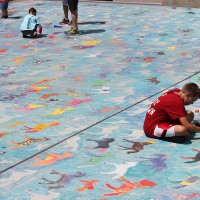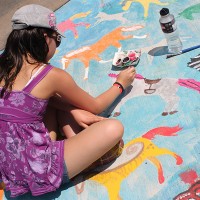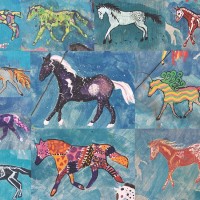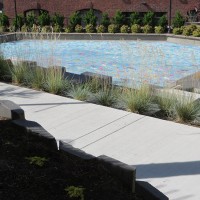900*Horses, 2015
Pulverized chalk pastel based paint, 2000sqft. Temporary.
900* Horses was a response to the difference between a monument and a memorial. While they both stand as marks of remembrance, they often represent divergent messages. Monuments are symbols of power; they celebrate and reinforce the primacy of a political or historical viewpoint. In 1946, a monument was erected to mark the location where in 1858, a herd of 800-1000 horses was separated from the Coeur d’Alene, Spokane, and Palouse and slaughtered under orders of U.S. Army Col. George Wright in a show of force to suppress the indigenous population. The horses were left on the banks of the Spokane River where their bleached bones could still be seen for over 50 years. The monument reads,
“IN 1858 COL. GEORGE WRIGHT WITH 700 SOLDIERS WAS SENT FROM WALLA WALLA TO SUPPRESS AN INDIAN OUTBREAK. AFTER DEFEATING THE INDIANS IN TWO BATTLES HE CAPTURED 800 INDIAN HORSES. TO PREVENT THE INDIANS FROM WAGING FURTHER WARFARE HE KILLED THE HORSES ON THE BANK OF THE RIVER DIRECTLY NORTH OF THIS MONUMENT—ERECTED AD 1946 THE SPOKANE COUNTY PIONEER SOCIETY ASSISTED BY SONS AND DAUGHTERS OF PIONEERS OF WASHINGTON AND LOYAL CITIZENS”
It is incidents like these that are vital to remember because they are access points. Often atrocities associated with warfare are ignored or actively condoned, as with the genocide of the indigenous population. However, when violent actions violate societally agreed upon “rules” of war, people are able to see the act of violence for what it is— to have the distance to understand the parallels between condoned violence, and to acknowledge the moral wrong.
In the act of making a memorial, we create a focus for our remembrance to honor the deceased. In this spirit, artist RYAN! FEDDERSEN led a community-enacted temporary mural, 900* horses, in the Tribal Gathering Plaza At Huntington Park to commemorate the horses and acknowledge the scale of the loss to tribes. From June 20th-28th 2015, participants were invited to honor the horses by claiming each figure of a horse to illustrate with care. Together, through concentrated attention on creating an effigy for each of the approximately 900 horses, the memorial symbolically recognized the individual lives, the scale of the event, and it’s significance on a personal level. It is estimated that over 700 participants completed approximately 800 horses, creating a figure for each of the horses killed in on the banks of the Spokane. Interestingly, nearly 150 horses remained empty stencils- the same number that was taken by the cavalry with the erroneous belief that they could make use of them. As the monument served to reinforce oppressive narratives, the mural sought to create a new conversation regarding the event that reinforced respect and a community coming together, side by side to create a new narrative.
Commissioned by Spokane Arts. Tribal Gathering Place, Spokane, WA

